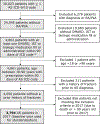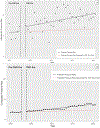Trends in Fracture Rates Over Two Decades Among Veterans With Ankylosing Spondylitis
- PMID: 37308459
- PMCID: PMC10704387
- DOI: 10.1002/acr.25166
Trends in Fracture Rates Over Two Decades Among Veterans With Ankylosing Spondylitis
Abstract
Objective: There is an increased risk of fracture in individuals with ankylosing spondylitis (AS) compared to the general population, possibly due to systemic inflammatory effects. The use of tumor necrosis factor inhibitors (TNFi) may reduce fracture risk by inhibiting inflammation. We assessed fracture rates in AS versus non-AS comparators and whether these rates have changed since the introduction of TNFi.
Methods: We used the national Veterans Affairs database to identify adults ≥18 years old with ≥1 International Classification of Diseases, Ninth Revision (ICD-9)/ICD-10 code for AS and at least 1 disease-modifying antirheumatic drug prescription. As comparators, we selected a random sample of adults without AS diagnosis codes. We calculated fracture incidence rates for AS and comparators, with direct standardization to the cohort structure in 2017. To compare fracture rates from 2000 to 2002 (pre-TNFi) versus 2004-2020 (TNFi era), we performed an interrupted time series analysis.
Results: We included 3,794 individuals with AS (mean age 53 years, 92% male) and 1,152,805 comparators (mean age 60 years, 89% male). For AS, the incidence rate of fractures increased from 7.9/1,000 person-years in 2000 to 21.6/1,000 person-years in 2020. The rate also increased among comparators, although the ratio of fracture rates (AS/comparators) remained relatively stable. In the interrupted time series, the fracture rate for AS patients in the TNFi era was nonsignificantly increased compared to the pre-TNFi era.
Conclusion: Fracture rates have increased over time for both AS and non-AS comparators. The fracture rate in individuals with AS did not decrease after TNFi introduction in 2003.
© 2023 American College of Rheumatology. This article has been contributed to by U.S. Government employees and their work is in the public domain in the USA.
Conflict of interest statement
Sali Merjanah: None
Jean Liew: Research grant from Pfizer that was completed in 2021 and unrelated to this work
John Bihn: None
Nathanael Fillmore: None
Mary Brophy: None
Nhan Do: None
Maureen Dubreuil: Advisory board honoraria from UCB and Amgen, unrelated to the current work, and a research grant from Pfizer, unrelated to the current work.
Figures



References
-
- Moltó A, Etcheto A, van der Heijde D, Landewé R, van den Bosch F, Bautista Molano W, et al. Prevalence of comorbidities and evaluation of their screening in spondyloarthritis: Results of the international cross-sectional ASAS-COMOSPA study. Ann Rheum Dis 2016;75:1016–23. - PubMed
-
- Nikiphorou E, Ramiro S, van der Heijde D, Norton S, Moltó A, Dougados M, et al. Association of Comorbidities in Spondyloarthritis With Poor Function, Work Disability, and Quality of Life: Results From the Assessment of SpondyloArthritis International Society Comorbidities in Spondyloarthritis Study. Arthritis Care Res (Hoboken) 2018;70:1257–62. - PubMed
-
- Fitzgerald G, Gallagher P, O’Shea FD. Multimorbidity in Axial Spondyloarthropathy and Its Association with Disease Outcomes: Results from the Ankylosing Spondylitis Registry of Ireland Cohort. J Rheumatol 2020;47:218–226. - PubMed
-
- Pray C, Feroz NI, Nigil Haroon N. Bone Mineral Density and Fracture Risk in Ankylosing Spondylitis: A Meta-Analysis. Calcif Tissue Int 2017;101:182–92. - PubMed
Publication types
MeSH terms
Substances
Grants and funding
LinkOut - more resources
Full Text Sources
Medical
Research Materials

